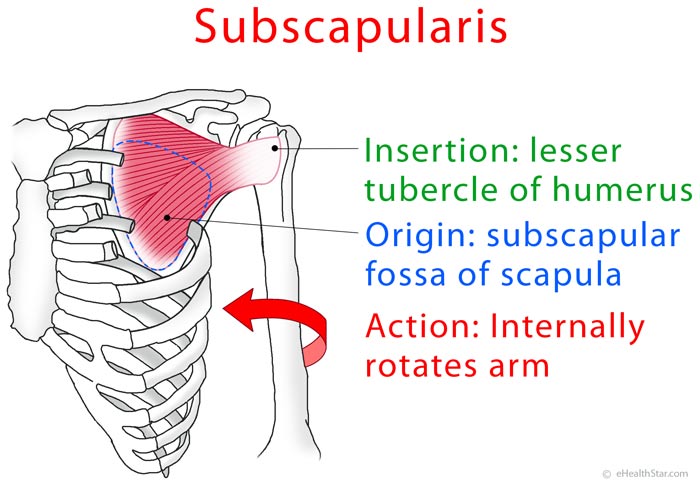Subscapularis Location
The subscapularis is one of the 4 rotator cuff muscles that embrace the shoulder joint (the other 3 being supraspinatus, infraspinatus and teres minor). It extends from the front side of the shoulder blade (scapula) to the upper part of the upper arm bone (humerus).
Origin
The subscapularis originates from the subscapular fossa of the scapula [1].
Insertion
The subscapularis inserts to the lesser tubercle of the humerus [1].
Functions (Actions)
- Internally (medially) rotates the arm and brings it to the body (adducts it)
- Stabilizes the humerus in the shoulder joint
- The tendon of the subscapularis muscle holds the tendon of the long biceps head in its place.
- Reference: [1]
Innervation
Subscapularis is innervated by the subscapular nerves that arise from the posterior cord of the brachial plexus, which arises from the spinal nerves C5, C6 and C7 [1].
Blood Supply
Subscapularis gets the blood via the subscapular artery [1].
Related anatomy:
Picture 1. Subscapularis anatomy: origin, insertion, function
(front view)
Subscapularis Tendinitis and Tear
Tendinitis means an inflammation of a tendon. Subscapularis tear often occurs together with the tear of other rotator cuff muscles [2].
Causes
- Overhead activities in sports, like tennis or baseball resulting in the impingement of subscapularis against the coracoid process of scapula
- Forced external rotation, like when someone pulls and twist your arm behind your body
- Fall onto an outstretched arm
- Shoulder dislocation
- References: [5]
Symptoms and Signs
- Pain and swelling at the front of the shoulder or back of the upper arm or down to the wrist
- Weakness in the arm during forward lifting and twisting the arm inwards
- Decreased range of motion in the shoulder
- Increased passive external rotation of an arm
- Pain during tests
- References: [2,4]
Tests
Tests for subscapularis tear (see Video 1 and Reference [4]):
- Resisted medial rotation
- Passive elevation of the arm
- Horizontal passive adduction
- Bear-hug test
- Belly press test
- Gerber’s lift-off test
A doctor can often make a diagnosis of subscapularis tear from symptoms and signs alone. The tear can be detected by arthroscopy, ultrasound and magnetic resonance imaging (MRI) but not by an X-ray [3].
Treatment
- Rest from painful activities; avoid external arm rotation (screwdriving, opening the door)
- Transverse friction massage to prevent the development of scar tissue (adhesions) twice a week for 3 weeks to 3 months
- Stretching exercises
- Severe inflammation: 1 or 2 steroid injections (cortisone)
- Chronic tear in older people: physiotherapy
- Acute tear in active persons: arthroscopic repair or open surgery
Stretching Exercises
Stretching exercises are intended to prevent the development of scar tissue around the tendon. They have to be performed every day for 6-8 weeks in order to be effective [4].
Exercise 1 [4]. Lie on the bed face up. Grip a 2-5 pound weight and bend the affected arm in the elbow by 90 degrees. Lower the forearm away from the body (but not beyond the point of pain) and hold for 30 seconds. Repeat 5 times and have few moments of rest between each repetition.
Exercise 2. Do the same as in exercise 1, but instead of just holding the weight, keep raising and lowering the forearm for 10 seconds. Repeat 3 times.
Video 1. Subscapularis anatomy, tear symptoms and tests
- References
- Subscapularis University of Washington, Department of Radiology
- Garavaglia G et al, 2011, The frequency of subscapularis tears in arthroscopic rotator cuff repairs: A retrospective study comparing magnetic resonance imaging and arthroscopic findings PubMed Central
- Subscapularis tendon tears Shoulderdoc.co.uk
- Shoulder Series #3: Subscapularis Tendinitis Massagetherapy.com
- Gothelf T, Subscapularis tears Orthosports.com.au


